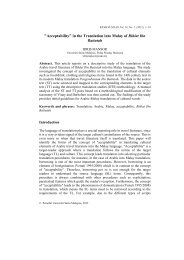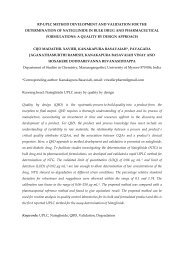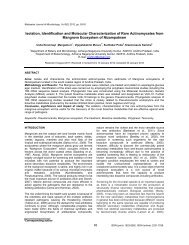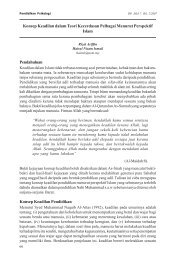Full Text - USM
Full Text - USM
Full Text - USM
Create successful ePaper yourself
Turn your PDF publications into a flip-book with our unique Google optimized e-Paper software.
Asian Academy of Management Journal, Vol. 12, No. 1, 35–50, January 2007<br />
AN EXAMINATION OF THE POTENTIAL IMPACT<br />
OF RISK ON VIABILITY ASSESSMENTS FOR<br />
FINANCIALLY DISTRESSED FIRMS: THE CASE<br />
OF PROFESSIONAL USER GROUPS OF<br />
COMPANY ACCOUNTS<br />
Sylvia Constantinides<br />
Icon – International Training, International Consulting,<br />
42a Dimitrakopoulou Street, Athens, 11742, Greece<br />
e-mail: sylvia_co@hotmail.com<br />
ABSTRACT<br />
Risky conditions in conjunction with individuals' attitude to risk would normally lead to<br />
risk-averse behavior (Fishbein & Ajzen, 1975; Ajzen & Fishbein, 1980). In this research,<br />
risk-averse behavior (the dependent variable) relates to the "going-concern" opinion of<br />
financially distressed firms. A logistic regression model used as predictors of risk<br />
measurements (risky conditions and risk attitude) correctly predicts 97.6% of the nongoing<br />
concern opinions. In conclusion, the empirical evidence demonstrates a subtle<br />
impact of risk on individuals' behavior despite the fact that distinct statistical tests do not<br />
fully support this.<br />
Keywords: going-concern, risk, auditors, financial distress, bankers, insolvency<br />
practitioners<br />
INTRODUCTION<br />
Viability assessments of financially distressed firms or otherwise their "goingconcern"<br />
status are inhibited by an innate problem as they can be self-fulfilling<br />
(Barnes, 1984; Cohen, 1978; Louwers, Messina, & Richards, 1999) despite some<br />
contrasting views (Citron & Taffler, 1992, 2001; Nogler, 2004). Furthermore,<br />
researchers have shown that auditor "going-concern" or otherwise opinion does<br />
not correspond with company status (Altman & McGough, 1974; Taffler &<br />
Tseung, 1984; Venuti, 2004). To complicate matters further, empirical evidence<br />
on auditor competence and independence has been contradictory (Barnes &<br />
Huan, 1993; Citron & Taffler, 1992; Davis, Ricchiute, & Trompeter, 1993; Lys<br />
& Watts, 1994; Ruiz-Barbadillo, Gomez-Aguilar, De Fuenttes-Barbera, &<br />
Garcia-Benau, 2004; Blay, 2005). Therefore, the apparent audit failure to<br />
distinguish between viable and non-viable firms might be attributed to other<br />
factors such as corporate governance information (Parker, Peters, & Turetsky,<br />
2002) or to behavioral factors (Kida, 1980; Huan, 1989; Barnes & Huan, 1993).<br />
35
Sylvia Constantinides<br />
Further, attitude theories of behavior suggest that risk aversion together with<br />
risky conditions lead to risk-averse behavior (Fishbein & Ajzen, 1975; Ajzen &<br />
Fishbein, 1980).<br />
Consequently, this study examined via a questionnaire the potential impact of<br />
individuals' perceived risks (risky conditions) and risk attitudes (risk aversion) on<br />
their "going-concern" opinions – risk-averse behavior (Newton, 1977; Furnham,<br />
1992; Mischel, 1993; Atkinson, Atkinson, Smith, Bem, & Hoeksema, 1996). It<br />
addresses three professional user groups of company accounts actively involved<br />
with viability assessments, namely auditors, bankers and insolvency practitioners<br />
(IPs).<br />
At the outset, auditors appear to be the only group involved with "going-concern"<br />
assessments either under normal conditions or under conditions of financial<br />
distress. However, interviews with practitioners, initially with auditors and later<br />
on with bankers and IPs, revealed that bankers and IPs are also involved with this<br />
process. Bankers are assessing the viability of their clients when granting a loan,<br />
or alternatively, when an existing client is facing financial difficulties (Grusd,<br />
2006). Similarly, IPs are assessing the viability of clients already in distress as<br />
their role is to determine the insolvency procedures (if any), that needed to<br />
be followed. Therefore, the context of financial distress justifiably appears to be a<br />
common denominator for examining and/or comparing the three groups. To the<br />
best of the author's knowledge, IPs are examined as a user group for the first time<br />
in this study. Further, bankers and auditors are examined (via a postal<br />
questionnaire) on these issues also for the first time. In essence, the originality of<br />
this study stems from the nature of the issues examined on these three groups<br />
including the methodology applied (questionnaire). Further, data is collected at<br />
an individual group level which can also be analyzed at a collective group level<br />
with the possibility of performing between-group comparisons.<br />
Results provide an insight regarding the nature of individuals' decision-making<br />
process, implying ways to improve practice but also the basis for further<br />
research.<br />
LITERATURE REVIEW<br />
Research on "going-concern" and/or viability assessments may be classified<br />
under (a) corporate failure prediction studies and (b) "going-concern" opinion<br />
studies. The former relates to numerous statistical models classifying firms as<br />
failed or otherwise, fraud with methodological and theoretical shortcomings.<br />
Specifically, most of these models were criticized for being theoretical as<br />
variable selection was based on their statistical significance (Barnes, 1984).<br />
36
Risk on viability assessments for financially distressed firms<br />
Furthermore, sample selection, statistical techniques applied and the properties of<br />
financial ratios (predictor variables) are also critically discussed (Einsenbeis,<br />
1977; Whittington, 1980; Barnes, 1982, 1984, 1986, 1987; Zmijewski, 1984).<br />
Evidence suggests that bankruptcy prediction models might not be an appropriate<br />
proxy for "going-concern" assessments in creditor-oriented countries as opposed<br />
to debtor-oriented ones (Brian, Tiras, & Wheatly, 2005; Kausar, Taffler, & Tan,<br />
2006; Kuruppu, Laswad, & Oyeler, 2003; Claessens & Klapper, 2005). Data<br />
mining techniques have also been applied in this context such as neural networks<br />
(NNs) and decision trees and proved to be more powerful for analyzing nonlinear<br />
and interaction relationships. Hence, these techniques are considered (at<br />
least) supplementary to the traditional statistical "going-concern" prediction<br />
models (Koh, 2004).<br />
"Going-concern" opinion studies are "behavioral" studies conducted under the<br />
auspices of the Human Information Processing (HIP) framework (Menon &<br />
Schwartz, 1987; Kennedy & Shaw, 1991; Chen & Church, 1992; Hopwood,<br />
McKeown, & Mutchler, 1994; Nogler, 1995; Guiral & Esteo, 2006). Drawn from<br />
psychology, the HIP framework provides the underlying theory for those studies<br />
examining individuals' decision-making process under conditions of uncertainty.<br />
However, the word behavioral may be a misnomer, as these studies do not<br />
actually examine behavioral factors but rather, the financial indicators that<br />
individuals use to reach a "going-concern" or otherwise decision. In brief,<br />
behavioral studies or, "Judgment and Decision-Maker" studies (Trotman, 1996)<br />
aim at developing a theory of individuals' perceptions of financial distress. It is<br />
noteworthy that, researchers adopting the cognitive approach (a competing<br />
paradigm), have provided useful insights in understanding and explaining<br />
individuals' judgment and final choice (see Ashton & Ashton, 1995; Libby &<br />
Lewis, 1977, 1982; Trotman, 1996).<br />
In conclusion, studies on "going-concern" opinion decisions do not adequately<br />
capture the impact of behavioral factors on individuals' judgment with a few<br />
exceptions (e.g. Kida, 1980). Although cognitive research on auditors' judgment<br />
provides important insights on individuals' decision-making process nonetheless,<br />
these are not pertinent in this context. Furthermore, no studies examining<br />
insolvency practitioners have been conducted, or any other comparing the three<br />
groups on "going-concern" opinions. Therefore, the current research aims at<br />
filling a significant gap in the literature by examining the impact of risk factors 1<br />
on the three groups' viability assessments for financially distressed firms.<br />
1 Measurement of these risk factors is explained later in the results section.<br />
37
Sylvia Constantinides<br />
THEORETICAL BACKGROUND<br />
As mentioned above, there exist two conflicting paradigms in the psychology<br />
domain namely the behavioral and the cognitive approach. The former predicts<br />
individuals' actions by observing their behavior whereas the latter attempts to<br />
obtain an in-depth understanding of their decision-making process by examining<br />
mental processes. The link between the two extremes is social psychology, which<br />
examines three core concepts namely, cognition (thoughts, beliefs, and attitudes),<br />
emotions (feelings) and behavior (actions) and how these are affected by the<br />
social environment (Furnham & Lewis, 1986).<br />
As discussed earlier, behavioral factors may account for the discrepancy between<br />
"going-concern" opinions and company status. Furthermore, social psychologists<br />
(Fishbein & Ajzen, 1975; Ajzen & Fishbein, 1980) provided the theoretical<br />
framework to explore the potential impact of risk on viability assessments<br />
namely the Theory of Reasoned Action. Specifically, the impact of risk on<br />
individuals' behavior may be examined using three (inter) related concepts: the<br />
interaction of (a) risk aversion (attitude) and (b) risky conditions<br />
(beliefs/thoughts) leading to (c) risk-averse behavior (action i.e., "going-concern"<br />
opinion or otherwise). Diagrammatically this is depicted as in Figure 1.<br />
Risk aversion<br />
(Attitude)<br />
Risky conditions<br />
(Perception)<br />
Risk-averse<br />
behavior<br />
Figure 1. Risk attitudes, perceptions and behavior<br />
Source: Adopted from Fishbein & Ajzen (1975), Ajzen & Fishbein (1980)<br />
Newton (1977) also argued that individuals' judgment is a function of the<br />
uncertainty surrounding the decision situation and their risk aversion. Risk<br />
aversion exemplifies individuals' willingness to accept the risk of making an<br />
incorrect decision whereas uncertainty lies on individuals' perceptions of risk.<br />
Therefore, individuals' actions would reflect their perceived risk; for example,<br />
auditor perceived risk would lead to a qualified audit report. On the other hand,<br />
risk attitude may account for any inconsistent behavior, e.g., a financially<br />
distressed firm classified as viable.<br />
38
Risk on viability assessments for financially distressed firms<br />
Finally, as decision-makers in this study represent three different groups,<br />
comparisons amongst them regarding the impact of the above (risk) factors in<br />
reaching a "going-concern" or otherwise, opinion are performed. It must also be<br />
emphasized that this study is conducted in the context of assessing financially<br />
distressed firms. As mentioned earlier, this is applied in order to have a common<br />
denominator to compare the views of the three groups, as normally IPs would<br />
only assess the viability of financially distressed firms.<br />
RESEARCH HYPOTHESES<br />
The crux of this research is that company viability assessments are influenced by<br />
behavioral factors. Further, psychology literature suggests that individuals'<br />
characteristics (personality) may affect or even bias their decision (e.g. Kline,<br />
1993). This research is delimited to the analysis of individuals' risk aversion (as a<br />
personality characteristic) including their perceived risks involved as critical<br />
factors in the context of "going-concern" assessments. Figure 2 depicts the<br />
presumed relationship between these constructs based on which the hypotheses<br />
are developed (adopted from Fishbein & Ajzen, 1975; Ajzen & Fishbein , 1980).<br />
Risky conditions<br />
Risk attitude<br />
Group<br />
Auditors<br />
Bankers<br />
IPs<br />
Going-concern opinion or otherwise<br />
Figure 2. The impact of risk on individuals' "going-concern" opinions<br />
The model is drawn using the path diagram terminology and it may be tested<br />
using structural equation modeling. However, as this research is exploratory and<br />
the model requires a strong underlying theory, it would be premature to test it at<br />
this stage (Tabachnick & Fidell, 1996). Consequently, the constituent parts of the<br />
model are tested separately under the alternative hypotheses, followed by a<br />
logistic regression model. Results then provide the basis for the model's further<br />
development and/or refinement.<br />
Differences are expected to exist between the three groups attributed to: (a) the<br />
different roles they assume (Jensen and Meckling, 1976), (b) the different risks<br />
they undertake, and (c) the different backgrounds they have leading to different<br />
risk attitudes. For example, auditors are presumed to preserve their clients'<br />
interests (Citron & Taffler, 2001) and bankers are preserving their bank's<br />
39
Sylvia Constantinides<br />
interests (Raby, 1992). On the other hand, IPs appear to be more independent in<br />
this context as they are only accountable to the courts (Lingard & Haag, 1992).<br />
Consequently, bankers and auditors are undertaking probably higher risks than<br />
the IPs because their jobs and career prospects are at stake. For example, for a<br />
Type 1 error, auditors risk lawsuits from stakeholders including damages to their<br />
reputation for failing to act in the public interest (Mong & Roebuck, 2005). On<br />
the other hand, for a Type 2 error, auditor risks involve deteriorating<br />
relationships with clients and adverse impact on their reputation (Nogler, 2006).<br />
Research hypotheses examine indiv idual group differences on risk factors and<br />
their impact on "going-concern" opinions including group comparisons.<br />
Consequently, the following hypotheses are set:<br />
H 1 :<br />
H 2 :<br />
H 3 :<br />
H 4 :<br />
There are statistically significant differences between the three groups<br />
on their perceived risk in the context of their "going-concern"<br />
assessments.<br />
There are statistically significant differences between the three groups<br />
on their risk-attitude.<br />
There are statistically significant differences between the three groups<br />
on their perceived risk and its relation to their "going-concern"<br />
opinion.<br />
There are statistically significant differences between the three groups<br />
on their risk-attitude and its relation to their "going-concern" opinion.<br />
METHODOLOGY<br />
The absence of (accounting) theories on "going-concern" assessments and/or<br />
corporate failure prediction of financially distressed firms triggered the need to<br />
conduct exploratory research interviews (Deshpande, 1983). These were<br />
conducted at the start of this research including the stage of the questionnaire<br />
design and its piloting. Consequently, interview results (with 13 practitioners)<br />
served the following purposes (see Sieber, 1973):<br />
(a) Confirmed the relevance and the importance of company viability<br />
assessments (particularly under conditions of financial distress) not only<br />
for auditors which is the obvious group but also, for bankers and<br />
insolvency practitioners and therefore, their inclusion in this study.<br />
(b) Determined the critical issues to examine particularly the importance of<br />
behavioral factors in this context.<br />
40
Risk on viability assessments for financially distressed firms<br />
(c) Supported the development of the research hypotheses.<br />
(d) Supported the questionnaire design including its piloting.<br />
However, the hypotheses set were tested solely using data collected via a postal<br />
questionnaire. This triangulation of research approaches or "middle-range<br />
thinking" (Laughlin, 1995) was performed acknowledging the complementary<br />
attributes of these two competing paradigms which were used to improve the<br />
quality of the research design (Brannen, 1992). Further, the careful drafting and<br />
piloting of the questionnaire eliminated the risk of non-response bias and the<br />
probability of receiving response sets of acquiescence (Aiken, 1997; Anastasi &<br />
Urbina, 1997). It also enhanced the generalizability, the face and content validity<br />
of the survey results. ANOVA procedures were also performed on important<br />
survey measurements comparing the alternative sets of responses and confirming<br />
the absence of non-response bias. 2<br />
The questionnaire was sent to representatives of auditors, bankers and insolvency<br />
practitioners in the UK. The sampling frame for the auditor population was the<br />
directory of practising auditors issued by ICAEW and ACCA whereas, for the<br />
IPs population was the Insolvency Service's directory of IPs. Systematic<br />
sampling was applied for auditors and IPs using probability sample design<br />
(Nachmias & Nachmias, 1996). A sample of 300 auditors and 300 IPs formed the<br />
mailing list for these two groups. On the other hand, non-probability sampling<br />
was used for bankers due to both the lack of a list of banker names (sampling<br />
frame) and bankers' inaccessibility. Therefore, individual bank managers at major<br />
clearing banks in Midlands, Yorkshire and London were contacted to distribute<br />
an agreed number of questionnaires (90) to their colleagues at various seniority<br />
levels and areas of specialization. This ensured an adequate sample in terms of<br />
geographical spread, seniority and specialization coverage. The control over the<br />
number of questionnaires sent out to bankers provided an estimate of the<br />
response rate but also of the non-response bias. Finally, as non-probability<br />
sampling was used for bankers, a small sample size was chosen to eliminate any<br />
inherent bias in the survey estimators (Kalton, 1983).<br />
The response rates for auditors and IPs was 22% (including questionnaires<br />
returned uncompleted) and for bankers 39% (no uncompleted questionnaires).<br />
These are satisfactory considering similar surveys (e.g. Robbie, 1993). Bankers'<br />
response rate was high strengthening the robustness of the results and offsetting<br />
any apparent limitations involved in the non-probability sampling process<br />
adopted. It is noteworthy that, coding the reminder questionnaires sent to bankers<br />
2<br />
Please contact the author for additional information.<br />
41
Sylvia Constantinides<br />
achieved zero response rate providing contradictory evidence to Kalafatis and<br />
Blankson (1996).<br />
Table 1<br />
Demographic Characteristics of the Respondents<br />
Age Gender *<br />
Mean<br />
M<br />
(%)<br />
F<br />
(%)<br />
P<br />
(%)<br />
Education *<br />
UP<br />
(%)<br />
PP<br />
(%)<br />
S<br />
(%)<br />
Company size<br />
M<br />
(%)<br />
L<br />
(%)<br />
Years at<br />
current<br />
post<br />
Mean<br />
Years at<br />
previous<br />
post(s)<br />
Auditors 41–45 85 15 47 40 6 83 10 7 6–10 6–10<br />
Bankers 36–40 87 9 66 21 4 64 4 32 0–5 0–5<br />
IPs 41–45 94 6 47 43 6 65 25 10 11–15 6–10<br />
Mean<br />
Notes: M = male; F = female; P = professional; UP = undergraduate & professional; PP = postgraduate & professional; S = small;<br />
M = medium; L = large<br />
*If total
Risk on viability assessments for financially distressed firms<br />
non-parametric statistics (Siegel & Castellan, 1988) as the data violated the<br />
normality assumption (K-S Lilliefors test).<br />
EMPIRICAL RESULTS<br />
Individuals' risk-averse behavior, that is "going-concern" opinion was measured<br />
using the variable "a financially distressed firm is not a going-concern" measured<br />
originally on a 5-point Likert-type scale and re-coded into a dummy variable.<br />
Their perceived risk (risky conditions) was measured using the variable<br />
"a financially distressed firm is risky". Both of these variables were derived from<br />
the interviews. Individuals' risk attitude was operationalized using Craig and<br />
Ginter's (1975) factor (scale) (as in Bearden, Netemeyer, & Mobley, 1993):<br />
• "I like to take a chance"<br />
• "I like people who are a little surprising" and<br />
• "When it comes to taking chances, I'd rather be safe than sorry"<br />
Descriptive statistics showed that individuals are risk-averse and perceive that<br />
there are risks involved in the context of assessing the viability of financially<br />
distressed firms. Pearson's Chi-Square test was also performed to test the<br />
independence between group identification and responses (Norusis, 1993).<br />
Results showed group consensus on these variables except for the risk attitude<br />
variable "I like to take a chance". Therefore, hypothesis H 2 is supported but not<br />
hypothesis H 1 . Chi-Square test was performed on each group separately to<br />
determine statistically significant individual group responses on their risk<br />
attitude, "I like to take a chance". Although Chi-Square tests are statistically<br />
significant at 1% for all groups, the pattern of the responses (Chi-Square test<br />
residuals 4 ) is only similar for auditors and bankers. Specifically, auditors<br />
and bankers disagreed that they like taking chances whereas IPs are less<br />
categorical about it. It is noteworthy that there was one response from an IP on<br />
the "strongly agree" category. Again, pair-wise group comparisons were also<br />
performed using Pearson's Chi-Square test to determine between which groups<br />
the differences are significant. Results confirm a consensus between auditors and<br />
bankers but not between them and IPs on this issue.<br />
4<br />
Chi-Square test residuals, represent the difference between observed and expected frequencies<br />
assuming that, each category has equal chances of occurrence (Norusis, 1993).<br />
43
Sylvia Constantinides<br />
Table 2<br />
Pearson's Chi-Square Test and Chi-Square Test on Individuals' Risk Attitude, Perceived<br />
Risk and Risk-Averse Behavior<br />
Pooled group sample<br />
Variable<br />
Pearson's Chi-Square test<br />
Risk attitude – Take chances 15.78 **<br />
Risk attitude – Safe than sorry 7.44<br />
Risk attitude – Like surprises 9.80<br />
Perceived risk – Financially distressed firm is risky 4.19<br />
Risk-averse behavior – Financially distressed firm is not a goingconcern<br />
5.74<br />
Individual group responses<br />
Auditors' x 2 Bankers' x 2 IPs'x 2<br />
Risk attitude – Take chances 15.33 * 10.52 * 27.04 *<br />
Pair-wise group comparisons<br />
Auditors vs. Bankers<br />
Pearson x 2<br />
Auditors vs. IPs<br />
Pearson x 2<br />
Bankers vs. IPs<br />
Pearson x 2<br />
Risk attitude – Take chances 1.79 10.32 ** 11.42 **<br />
Notes: * Significant at 1%<br />
** Significant at 5%<br />
Next, Spearman's rank correlation coefficients (SRCC) 5 were estimated between<br />
individuals' perceived risks and risk attitudes with their "going-concern" opinion<br />
to test hypotheses H 3 and H 4 . Results showed that for neither group, risk attitude<br />
was correlated with their "going-concern" opinion reinforcing the quality of their<br />
decision (Constantinides, 2001). Although bankers' perceived riskiness was<br />
significantly correlated (30%) with their "going-concern" opinion, this finding<br />
should not raise any concerns as this is normally expected. In brief, hypothesis<br />
H 3 is supported whereas hypothesis H 4 is not.<br />
Finally, using the "going-concern" opinion dummy as the dependent variable, a<br />
logistic regression model was developed with an overall correct classification of<br />
73.9% but with classification for the "non-going-concern" of 97.6%. The model<br />
was developed using forward stepwise selection (conditional) and after<br />
controlling for the demographic variables, i.e., age, gender, group identification,<br />
education and years of experience. This was performed in order to avoid results<br />
being biased due to these variables enabling us to have a clear indication of the<br />
impact of risk factors in this context. 6<br />
5<br />
6<br />
SRCC was applied as data does not satisfy the normality assumption (Norusis, 1993: 297).<br />
Controlling for the impact of factors outside the interest of the study is a standard practice. For<br />
example, readers may refer to Citron and Taffler's (2004) controlling for the impact of changes in<br />
the economic environment.<br />
44
Risk on viability assessments for financially distressed firms<br />
Table 3<br />
Logistic Regression Model of "Going-Concern" Opinions using Stepwise Forward<br />
Selection on Individuals' Perceived Risk and Risk Attitudes after Controlling for<br />
Demographic Variables<br />
Variable B S.E. Wald d.f. Sig. Exp(B)<br />
Demographics – Age –0.200 0.115 3.021 1 0.082 0.819<br />
Perceived risk – Financially 0.286 0.158 3.266 1 0.071 1.331<br />
distressed firm is risky<br />
Risk attitude – Like chances –0.074 0.199 0.141 1 0.707 0.928<br />
Risk attitude – Safe than sorry –0.301 0.198 2.315 1 0.128 0.740<br />
Risk attitude – Like surprises 0.112 0.183 0.371 1 0.542 1.118<br />
The resulting model included risk attitude measurements, perceived risky<br />
conditions and individuals' age as independent variables. In other words, the final<br />
model using the forward stepwise selection method included only one<br />
demographic variable as being significant i.e., the age of the respondents.<br />
Unfortunately, the interpretation of logistic regression coefficients was not as<br />
straightforward as the ones of a linear regression. In essence, the logistic<br />
regression model can be rewritten in terms of the odds of an event occurring i.e.,<br />
the ratio of the probability of an event occurring to the probability that it will not<br />
occur (Norusis, 1994). Therefore, the probability of having a "going-concern"<br />
opinion, i.e., P(gc) = 1/1+e –z where, z = –0.200 (age) + 0.286 (perceived risk)<br />
– 0.074 (risk-chance) – 0.0301 (risk-safe) + 0.112 (risk-surprises). Thereafter,<br />
substituting values for these variables we can estimate the probability of having a<br />
"going-concern" opinion decision.<br />
The Chi-Square test, which assessed model's goodness of fit, was significant<br />
at 1%. It should be noted the model's weakness in correctly classifying "goingconcerns"<br />
(21.6%). However, Type II error that is, failure to reject the null<br />
hypothesis that the company is a "going-concern" may be more serious than Type<br />
I error.<br />
SUMMARY AND CONCLUSIONS<br />
According to the Theory of Reasoned Action (Fishbein & Ajzen, 1975; Ajzen &<br />
Fishbein, 1980), individuals' risk attitude in conjunction with risky conditions<br />
would lead to risk-averse behavior. This theory is examined in the context of<br />
viability assessments for financially distressed firms as performed by three<br />
professional user groups of company accounts, namely auditors, bankers and IPs.<br />
Taking the analogy that a financially distressed firm is risky, i.e., representing<br />
risky conditions, together with a measurement of individuals' risk attitude it is<br />
45
Sylvia Constantinides<br />
expected that these two would lead a company being classified as a non-viable<br />
(risk-averse behavior).<br />
The data was collected via a questionnaire on a representative sample of the<br />
above mentioned professional user groups of company accounts in the UK during<br />
1998–1999 (approximately 140 cases). Results confirmed a group consensus<br />
regarding the risks involved in assessing the viability or otherwise, the "goingconcern"<br />
status of financially distressed firms. Further, all three groups appear to<br />
be risk-averse. However, there exist some between-group differences regarding<br />
the degree of their risk aversion. Further, only bankers' perceived riskiness of the<br />
situation was positively related to their "going-concern" opinion whereas all three<br />
groups' risk attitude were not significantly correlated with their "going-concern"<br />
opinion. Nonetheless, using the risk measurements as independent variables in a<br />
logistic regression model, the latter correctly predicted 97.6% of the non-going<br />
concern opinions suggesting the formers' subtle impact in this context.<br />
In conclusion, behavioral factors and particularly risk-related factors appear to be<br />
relevant in the context of "going-concern" assessments as one would normally<br />
expect. Further, logistic regression results confirm their subtle impact on<br />
auditors', bankers' and IPs' "going-concern" opinion decisions. Despite<br />
considering this finding as not alarming, it should trigger professionals'<br />
obligation to re-consider the impact of risk in their decision-making process<br />
in this context. Future research may re-examine these issues using alternative<br />
measurements of risk and/or the potential impact of other (intervening)<br />
behavioral factors on individuals' judgment before any solid conclusions can be<br />
drawn. The latter may involve individuals' potential use of heuristics or the<br />
application of personality scales (Kline, 1993).<br />
Finally, it should be noted that results are preliminary in the sense that these<br />
issues are examined for the first time using a postal questionnaire. Further, results<br />
should be interpreted with care as one may question the sample 's<br />
representativeness considering that 85% or above of the respondents are male s.<br />
However, this argument may not be able to be defeded considering that banking<br />
and/or accountancy are male dominated professions (Flynn, Leeth, & Levy,<br />
1996).<br />
REFERENCES<br />
Aiken, L. R. (1997). Psychological testing and assessment. USA: Allyn & Bacon.<br />
Ajzen, I., & Fishbein, M. (1980). Understanding attitudes and predicting social<br />
behaviour. Englewood Cliffs, NJ: Prentice-Hall.<br />
46
Risk on viability assessments for financially distressed firms<br />
Altman, E. I., & McGough, T. P. (1974). Evaluation of a company as a going concern,<br />
The Journal of Accountancy, December, 50–57.<br />
Anastasi, A., & Urbina, S. (Eds.). (1997). Psychological testing. USA: Prentice-Hall Inc.<br />
Ashton, R. H., & Ashton, A. H. (1995). Judgment and decision-making research in<br />
accounting. UK: Cambridge University Press.<br />
Atkinson, R. L., Atkinson, R. C., Smith, E. E., Bem, D. J., & Hoeksema, S. N. (1996).<br />
Hilgard's introduction to psychology. USA: Harcourt Brace & Company.<br />
Barnes, P. (1982). Methodological implications of non-normally distributed financial<br />
ratios. Journal of Business Finance and Accounting, 9(1), 51–62.<br />
. (1984). The application of multiple discriminant analysis in the prediction of<br />
company failure – An example of an undesirable consequence of the information<br />
technology revolution. Managerial Finance, 10(1), 11–14.<br />
. (1986). The statistical validity of the ratio method in financial analysis: An<br />
empirical examination: A comment. Journal of Business Finance and Accounting,<br />
13(4), 627–635.<br />
. (1987). The analysis and use of financial ratios: A review article. Journal of<br />
Business Finance and Accounting, 14(4), 450–458.<br />
Barnes, P., & Huan, H. D. (1993). The auditor's going-concern decision: Some UK<br />
evidence concerning independence and competence. Journal of Business Finance<br />
and Accounting, 20(2), January, 213–228.<br />
Bearden, W. O., Netemeyer, R. G., & Mobley, M. F. (1993). Handbook of marketing<br />
scales. USA : Sage Publications.<br />
Blay, A. (2005). Independence threats, litigation risk and the auditor's decision process.<br />
Contemporary Accounting Research, 22(4), 759.<br />
Brannen, J. (Ed.). (1992). Combining qualitative and quantitative approaches: An<br />
overview. In Mixing methods: Qualitative and quantitative research. UK: Avebury,<br />
3–37.<br />
Brian, D., Tiras, S. L., & Wheatley, C. M. (2005). Do going concern opinions serve as<br />
early warnings of financial collapse? (Working paper). Buffalo : State University of<br />
NY.<br />
Chen, K. C. W., & Church, B. K. (1992). Default on debt obligations and the issuance of<br />
going-concern opinions. Auditing: A Journal of Practice and Theory, 11(2), Fall, 30–<br />
49.<br />
Citron, D. B., & Taffler, R. J. (1992). The audit report under going concern uncertainties:<br />
An empirical analysis. Accounting and Business Research, 22(88), 337–345.<br />
. (2001). Ethical behaviour in the UK audit profession: The case of the selffulfilling<br />
prophecy under going-concern uncertainties. Journal of Business Ethics,<br />
29(4), February, 353–363.<br />
. (2004). The comparative impact of an audit report standard and an audit goingconcern<br />
standard on going-concern disclosure rates. Auditing: A Journal of Practice<br />
& Theory, 23.<br />
Claessens, S., & Klapper, L. F. (2005). Bankruptcy around the world: Explanations of its<br />
relative use. American Law and Economics Review 2005, 7(1), 253–283.<br />
Cohen, M. (1978). Report conclusions and recommendations. In The commission on<br />
auditor's responsibilities.<br />
47
Sylvia Constantinides<br />
Constantinides, S. (2001). Going-concern assessments for financially distressed firms:<br />
Factors influencing the quality of the judgement of auditors, bankers and insolvency<br />
practitioners (pp. 326–345). 1 st EARNet Convention, Germany.<br />
. (2002). Auditors', bankers' and insolvency practitioners' "going-concern"<br />
opinion logit model. Managerial Auditing Journal, 17(8), 487–501.<br />
Davis , R., Ricchiute, N., & Trompeter, G. (1993). Audit effort, audit fees and the<br />
provision of non-audit services to audit clients. The Accounting Review, 68(1),<br />
January, 135–150.<br />
Deshpande, R. (1983). Paradigms lost: On theory and method in research in marketing.<br />
Journal of Marketing, 47, Fall, 101–110.<br />
Eisenbeis , R. A. (1977). Pitfalls in the application of discriminant analysis in business<br />
finance and economics. Journal of Finance, 32(3), June, 875–899.<br />
Fishbein, M., & Ajzen, I. (1975). Belief, attitude, intention and behaviour. Reading,<br />
Mass: Addison-Wesley.<br />
Flynn, P. M., Leeth, J. D., & Levy, E. S. (1996). The evolving gender mix in accounting:<br />
implications for the future of the profession. Selections, Winter, 28–39.<br />
Furnham, A. (1992). Personality at work: The role of individual differences in the<br />
workplace. London: Routledge.<br />
Furnham, A., & Lewis , A. (1986). The economic mind: The social psychology economic<br />
behaviour. UK: Wheatsheaf Books Ltd.<br />
Grusd, N. (2006). Going, going, gone! The Secured Lender, 62(4), 62–64.<br />
Guiral, A., & Esteo, F. (2006). Are Spanish auditors skeptical in going concern<br />
evaluations? Managerial Auditing Journal, 21(6), 598–623.<br />
Hair, J. F. Jr., Anderson, R. E., Tatham, R. L., & Black, W. C. (1995). Multivariate data<br />
analysis. USA: Prentice-Hall Inc.<br />
Hopwood, W., McKeown, J. C., & Mutchler, J. F. (1994). A re-examination of auditor<br />
versus model accuracy within the context of the going-concern opinion decis ion.<br />
Contemporary Accounting Research, 10(2), 409–431.<br />
Huan, D. H. (1989). Audit considerations in assessing the application of the going<br />
concern concept. Doctoral dissertation, University of Manchester.<br />
Jensen, M. C., & Meckling, W. H. (1976). Theory of the firm: Managerial behaviour,<br />
agency costs and ownership structure. Journal of Financial Economics, 3, 305–360.<br />
Kalafatis , S. P., & Blankson, C. (1996). An investigation into the effect of questionnaire<br />
identification numbers in consumer mail surveys. Journal of the Market Research<br />
Society, 38(3), 277–284.<br />
Kalton, G. (1983). Introduction to survey sampling. USA: Sage Publications Inc.<br />
Kausar, A., Taffler, R. J., & Tan, C. E. L. (2006). The impact of bankruptcy code on the<br />
value of the auditor's going-concern opinion to investors (Working paper). UK:<br />
University of Edinburgh.<br />
Kennedy, D. B., & Shaw, W. H. (1991). Evaluating financial distress resolution using<br />
prior audit opinions. Contemporary Accounting Research, 8(1), 97–114.<br />
Kida, T. (1980). An investigation into auditors' continuity and related qualification<br />
judgments. Journal of Accounting Research, Autumn , 506–523.<br />
Kline, P. (1993). The handbook of psychological testing. London: Routledge.<br />
Koh, H. C. (2004). Going concern prediction using data mining techniques. Managerial<br />
Auditing Journal, 19(3), 462.<br />
48
Risk on viability assessments for financially distressed firms<br />
Kuruppu, N., Laswad, F., & Oyeler, P. (2003). The efficacy of liquidation and<br />
bankruptcy prediction models for assessing going concern. Managerial Auditing<br />
Journal, 18(6/7), 577–590.<br />
Laughlin, R. (1995). Methodological themes – Empirical research in accounting:<br />
Alternative approaches and a case for 'middle-range' thinking. Accounting, Auditing<br />
and Accountability Journal, 8(1), 63–87.<br />
Libby, R., & Lewis , B. L. (1977). Human information processing research in accounting:<br />
The state of the art. Accounting, Organizations and Society, 2(3), 245–268.<br />
. (1982). Human information processing research in accounting: The state of the<br />
art in 1982. Accounting, Organizations and Society, 7(3), 231–285.<br />
Lingard, J., & Haag, H. (1992). Administration and insolvency: United Kindgdom and<br />
German approaches. In R. Cranston (Ed.). Banks and remedies. London: Lloyd's of<br />
London Press Ltd.<br />
Louwers, T. J., Messina, F. M., & Richard, M. D. (1999). The auditor's going-concern<br />
disclosure as a self-fulfilling prophecy: A discrete – Time survival analysis . Decision<br />
Sciences, 30(3), Summer, 805–824.<br />
Lys, T., & Watts, R. L. (1994). Lawsuits against auditors. Journal of Accounting<br />
Research, 32(Suppl.), 65–93.<br />
Menon, K., & Schwartz, K. B. (1987). An empirical investigation of audit qualification<br />
decisions in the presence of going-concern uncertainties. Contemporary Accounting<br />
Research, 3(2), Spring.<br />
Mischel, W. (1993). Introduction to personality. USA: Holt, Rinehart & Wilson, Inc.<br />
Nachmias, C. F., & Nachmias, D. (1996). Research methods in the social sciences,<br />
London: Arnold.<br />
Newton, L. K. (1977). The risk factor in materiality decisions. Accounting Review, 52,<br />
97–108.<br />
Mong, S., & Roebuck, P. (2005). Effect of audit report disclosure on auditor litigation<br />
risk. Accounting and Finance, 45, 145–169.<br />
Nogler, G. E. (1995). The resolution of auditor going concern opinions. Auditing: A<br />
Journal of Practice and Theory, 14(2), Fall, 54–73.<br />
. (2004). Long-term effects of the going concern opinion. Managerial Auditing<br />
Journal, 19(5), 681–688.<br />
. (2006). The changing information content of auditor going-concern opinions.<br />
Commercial Lending Review, 21(1), January/February, 43–47.<br />
Norusis , M. J. (1993). SPSS for Windows: Base system user's guide. USA: SPSS Inc.<br />
. (1994). SPSS advanced statistics 6.1. USA : SPSS Inc.<br />
Nunnally, J. C. (1978). Psychometric theory. New York: McGraw-Hill.<br />
Oppenheim, A. N. (1992). Questionnaire design, interviewing and attitude measurement.<br />
London: Pinter Publishers Ltd.<br />
Parker, S., Peters, G., & Turetsky, H. (2002). Corporate governance factors and auditor<br />
going-concern assessments. Preliminary working paper presented at the 2002 AAA<br />
Western Regional Meeting, San Diego, CA.<br />
Raby, P. (1992). Law relating to banking services (2 nd ed.). London: Pitman Publishing.<br />
Riley, M., Wood, C. R., Clark, M. A., Wilkie, E., & Szivas, E. (2000). Researching and<br />
writing dissertations in business and management. London: Thomson Learning.<br />
49
Sylvia Constantinides<br />
Robbie, K. (1993). The contribution of management buy-ins to corporate restructuring:<br />
Concepts, characteristics and performance. Doctoral dissertation, University of<br />
Nottingham.<br />
Ruiz-Barbadillo, E., Gomez-Aguilar, N., De Fuentes-Barbera, C., & Garcia -Benau, M. A.<br />
(2004). Audit quality and the going-concern decision-making process: Spanish<br />
evidence. European Accounting Review, 13(4), December, 597–620.<br />
Sieber, S. D. (1973). The integration of field work and survey methods. American<br />
Journal of Sociology, 78, 1335–1359.<br />
Siegel, S., & Castellan, N. J. Jr. (1988). Non-parametric statistics for the behavioural<br />
sciences. USA : McGraw-Hill Inc.<br />
Tabachnick, B. G., & Fidell, L. S. (1996). Using multivariate statistics. USA : Harper<br />
Collins Publishers Inc.<br />
Taffler, R. J., & Tseung, M. (1984). The audit going-concern Qualification in practiceexploding<br />
some myths. The Accountants' Magazine, July, 263–269.<br />
Trotman, K. T. (1996). Research methods for judgment and decision-making studies in<br />
auditing. Australia: Coopers & Lybrand.<br />
Venuti, E. K. (2004). The going-concern assumption revisited: Assessing a company's<br />
future viability. The CPA Journal, 74(5), 40–43.<br />
Whittington, G. (1980). Some basic properties of accounting ratios. Journal of Business<br />
Finance and Accounting, Summer, 219–233.<br />
Zmijewski, M. E. (1984). Methodological issues related to the estimation of financial<br />
distress prediction models. Journal of Accounting Research, 22(Suppl.), 59–82.<br />
50


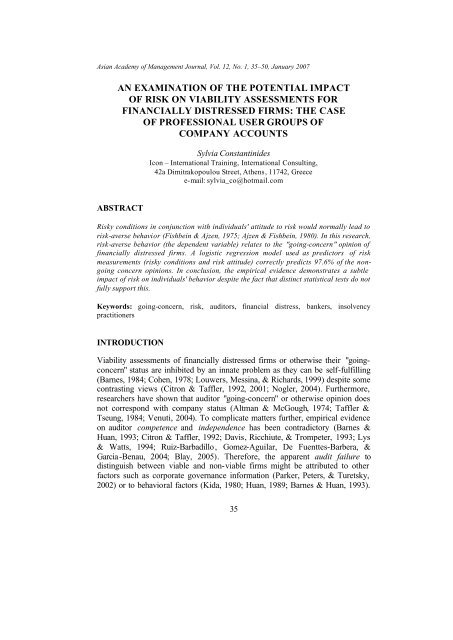
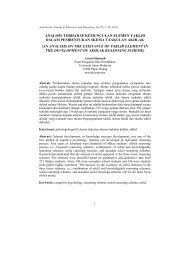
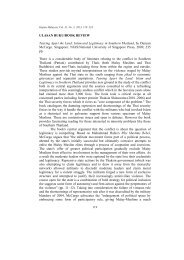

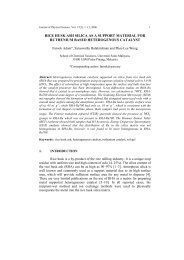

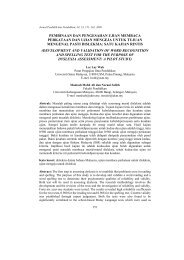
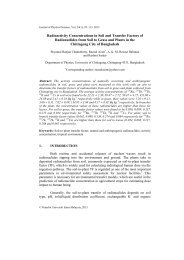
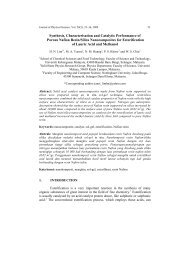

![KTT 111 – Inorganic Chemistry I [Kimia Takorganik I] - USM](https://img.yumpu.com/12405642/1/184x260/ktt-111-inorganic-chemistry-i-kimia-takorganik-i-usm.jpg?quality=85)
